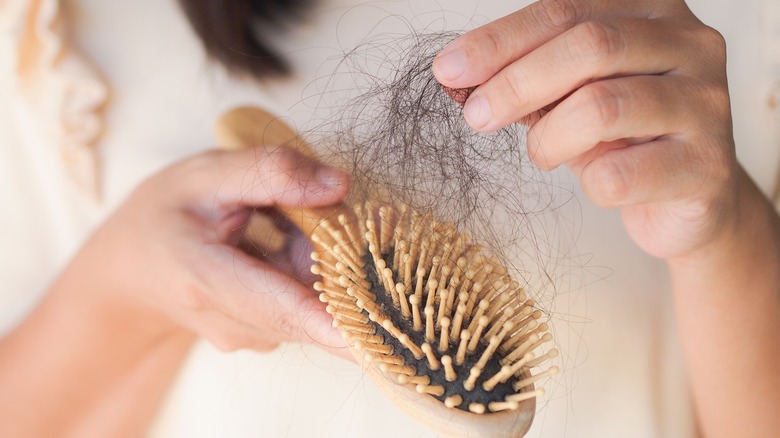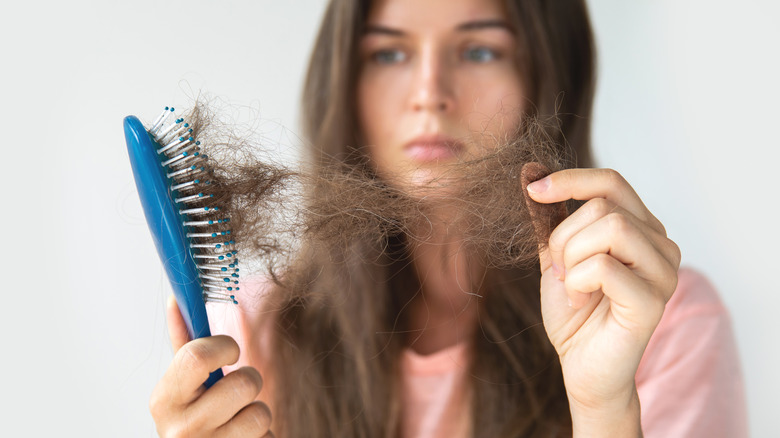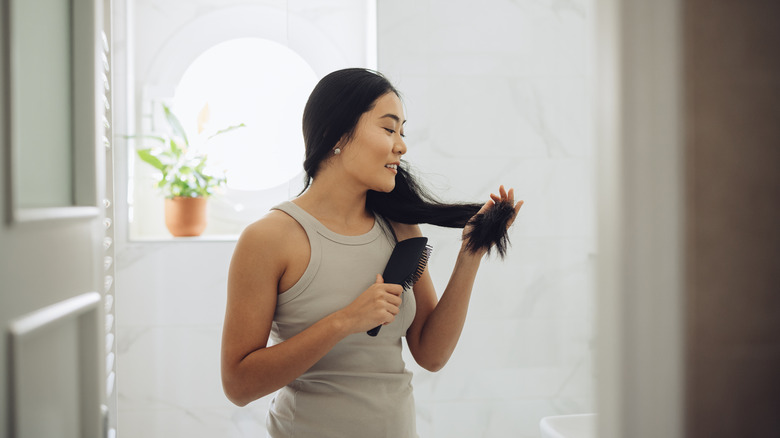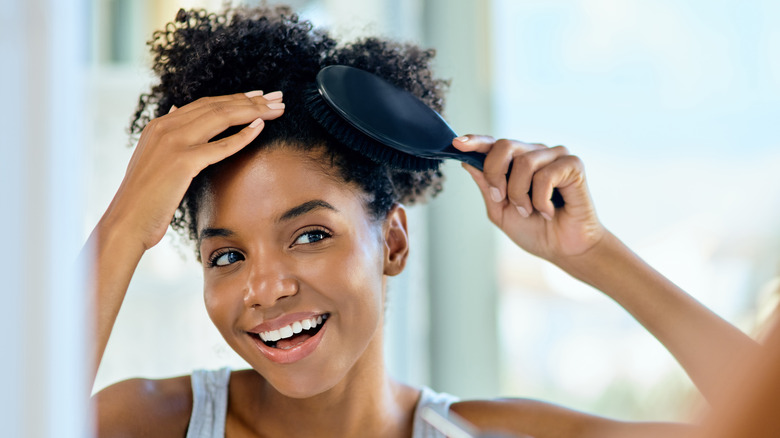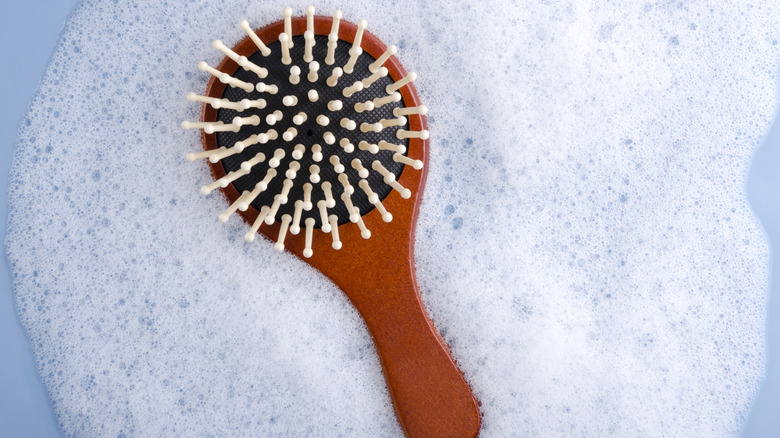Our Best Tips & Tricks For Cleaning Your Hair Brush
Let's be honest. Many of us probably take it as a sign to clean our hair brushes once we notice it's totally covered in tangled knots. But here's the thing: Every time you use a brush, strands of hair and product can accumulate on it. And if you're not taking the time to clean it every once in a while, that means you're using a dirty tool on your mane.
Cleaning your hair brushes isn't just important for hygiene. It's also key for observing and tracking possible hair loss as well. According to the American Academy of Dermatology Association, it's normal to shed around 50-100 hairs a day. It can also increase or decrease depending on level of stress and general holistic health, such as diet, exercise, and hair products. Committing to a regular brush clean routine can help you stay aware of whether you're dealing with normal shedding or something more serious.
Through cleaning, you may also find a buildup of product residue, dandruff, and dead hairs that can help track down the direct cause of what's making your hair shed. It's clear keeping your hair brushes and combs clean is essential part of maintaining your hair health. But it's not as straightforward as you might think. Here's everything to know — from how often to clean them, to whether you need special products to do it.
How often to clean your hair brush
Cleaning your hair brush isn't just for the aesthetic — it's also important to get the most mileage out of your hair products. According to hairstylist Tukia Allen, "[The buildup] can prevent your tools from working at full capacity," she explained to Allure. Cleaning your hair tools rids the product of residue and ultimately enhances its effects. If you're someone who frequently straightens or curls their hair (which should be used with a heat protectant), a clean hair brush will allow you to use the bristles to guide the hair and achieve a healthy and clean result. As hairstylist Laura Polko explained to Allure, "If you're using a round brush for a blowout, you [won't be able to] get the hair all the way in the brush because it's backed up with old hair." Hence, make sure you're cleaning out your hair brush before using styling products.
In terms of frequency, hair brushes should be cleaned at least once a week, especially if it's used daily. On the other hand, if you're not someone who frequently uses your hair brush or other hair products, aim for a cleaning every 2-3 weeks instead. Be sure to keep an eye on residue buildup to get a proper gauge on when to clean it!
Always remove hair first
Let's get started! The first step is always to remove the hair from the brush with a bristle hair remover. If you don't have these removal items, try using alternatives like pens, forks, or chopsticks. According to trichologist William Gaunitz, removing the hair first will help avoid any resistance from other cleaning products. "As the hair gets tangled in the brush, it is going to create more resistance while you're brushing," he explained to The New York Times. "That's creating a greater tugging action, which could lead to more breakage or shedding." Once your hair has been removed, it's time to clean.
Fill a tub full of warm water and dish or body wash until it gets soapy and place your hairbrush in for approximately 10 minutes. For wooden brushes, dip your bristles in the water and use a toothbrush or other prong to clean around the bristles. Once the brush is cleaned until you're satisfied, rinse and dry it off. According to hair stylist Katharine Boss, drying is an essential part of the step. "You definitely want to avoid water getting trapped inside of your brush as this could cause bacteria to grow," she explained to The New York Times. Once the leftover moisture dries, your hair brush is clean.
Liquid soap is the best cleaner
Much like makeup brushes, your hair brushes can accumulate a lot of buildup. That means sometimes even if you pull off all the visible hair, there could be remnants of old product in the bristles. Thankfully, you only need a few tools to properly clean out the gunk from your hairbrush, according to The New York Times. For synthetic hair brushes — which are often the most commonly used hair brushes — all you need is liquid soap, a bristled cleaning product, water, and a towel. Feel free to substitute these products with those that you prefer (and have a similar effect). You can also use a rat tail brush to help pull out the pesky hairs that stick to the surface of the hair brush.
The fastest and most efficient process can also include a tub filled with water and your favorite universal cleaning product, which can help quickly remove surface-level hairs as well as incognito product residue. For those of us who frequently wash our favorite makeup brushes and beauty blenders, you may already have these tools and products on hand. We'll dive more into the hair removal process in the next slide, but make sure to gather your favorite cleaning products beforehand!
Don't treat all your brushes the same
Different hair brushes require different methods of cleaning, and that starts with identifying the material of your hairbrush. According to trichologist William Gaunitz, certain materials can harbor bacteria. Lingering strands of hair can cause "additional bacteria and fungus can grow on the material inside the brush," he explained to The New York Times. For example, synthetic brushes require soap that can create a foamy barrier around the brush — dish soap, shampoo, and body wash are all effective examples. On the other hand, brushes that are made with natural materials like wood and bristles will benefit more from gentle products that avoid ingredients like sulfate.
The best hair brush can vary depending on hair type, and finding the right one for you will noticeably help achieve best results in terms of hair loss, growth, and cleaning. While they are capable of being cleaned, brushes with metal bristles should be avoided, according to hairstylist JB Shelton. Bristles with a metal-like pull "will tear your hair up," he explained to Today. For heat styling, opt for hair brushes that use a ceramic or ion material.
Get rid of brushes that aren't working for you
There are a few tips you should be mindful of when using and cleaning your hair brush. If you lose excessive amounts of hair, it's best to avoid brushes entirely and opt for combs instead (which must also be cleaned routinely). A rat tail or regular comb can help resolve a significant amount of hair shed and should be combed from bottom to top. There are a number of ways to effortlessly detangle long hair that don't sacrifice a huge chunk of hair, and that will ultimately promote better hair health.
In addition, avoid excessive residue build up by using a scalp massager in the shower to remove product buildup without leaving it in the hands of your hair brush. Avoid brushing your hair dry throughout the week and instead use finger combing to work through tangles. Once you've established an effective hair care and cleaning routine, you'll notice incredible results over time.
